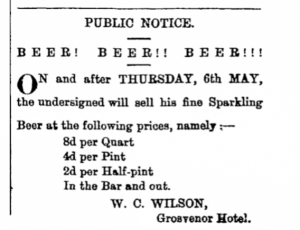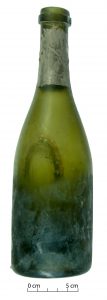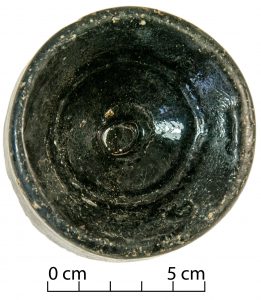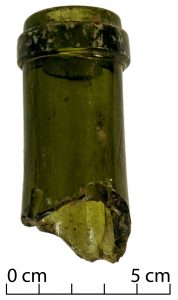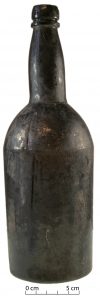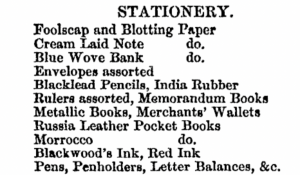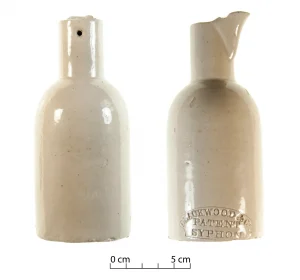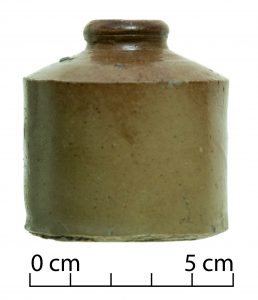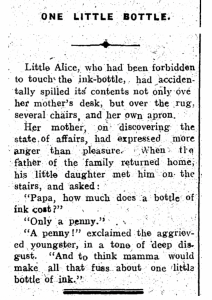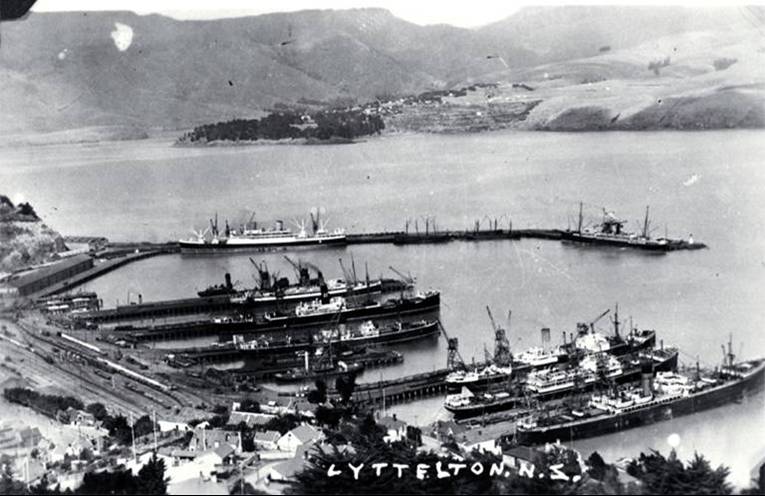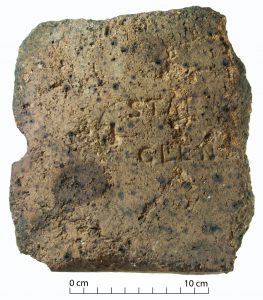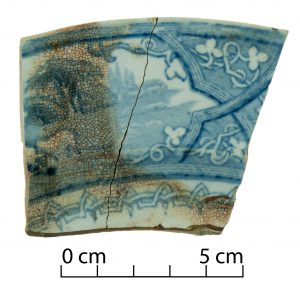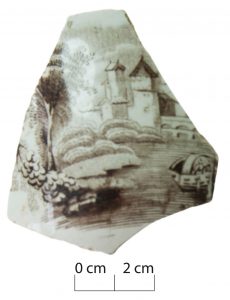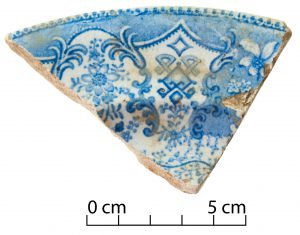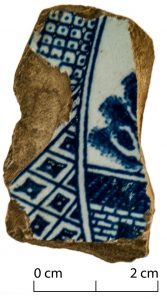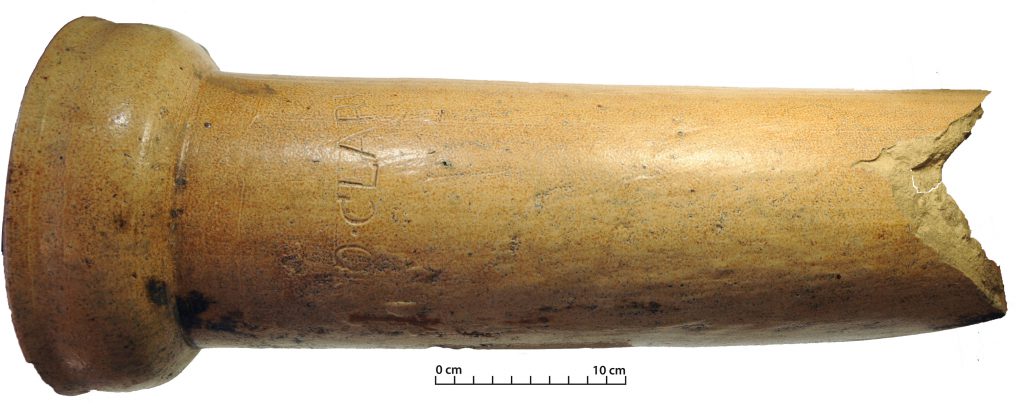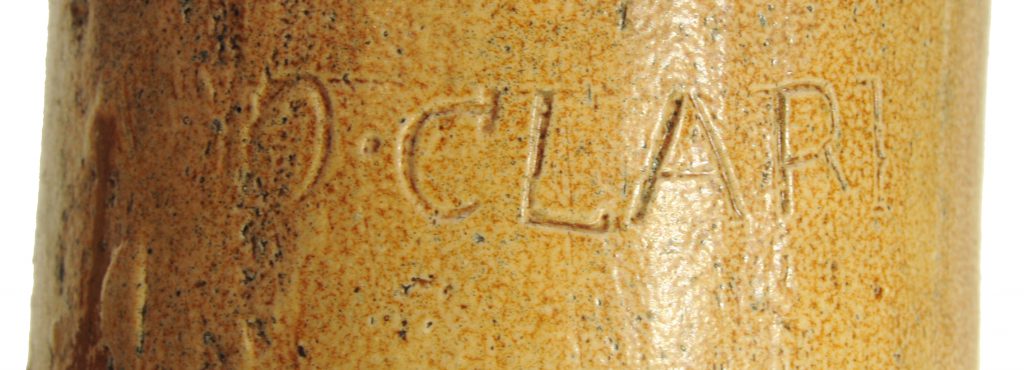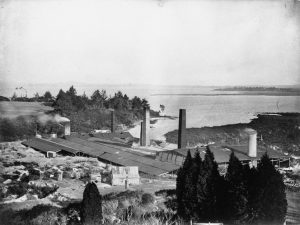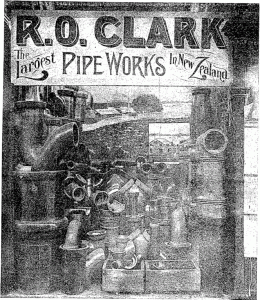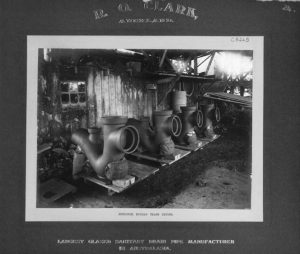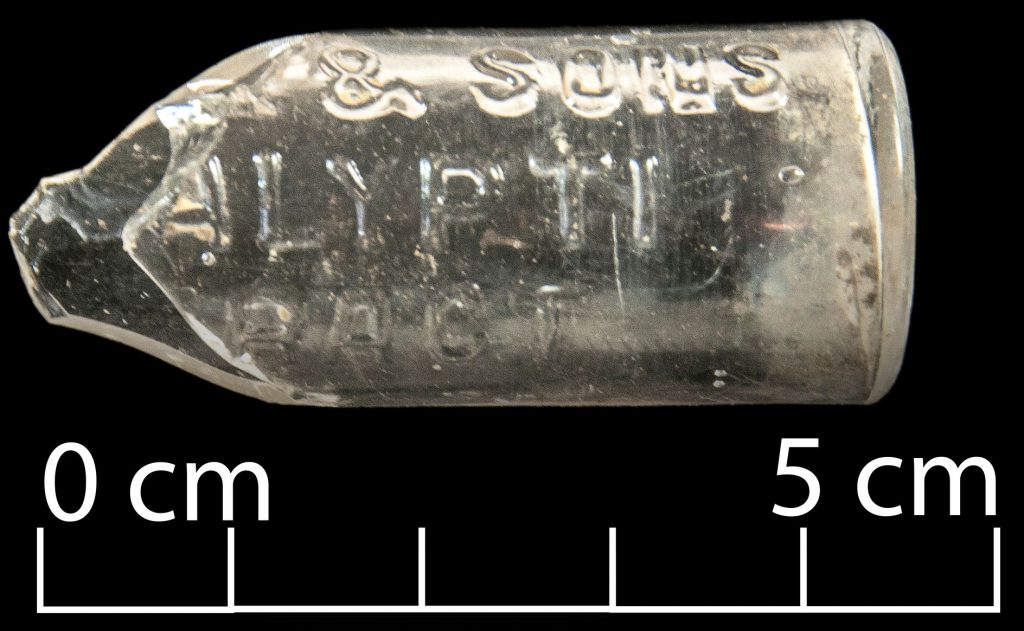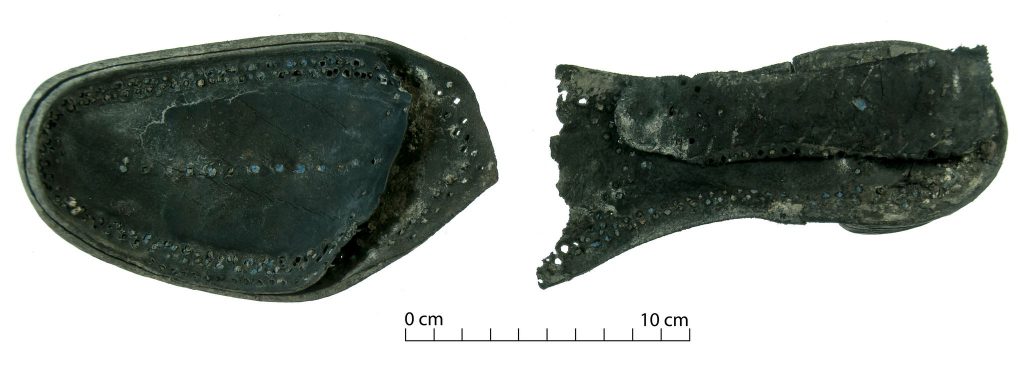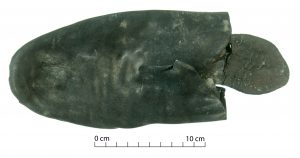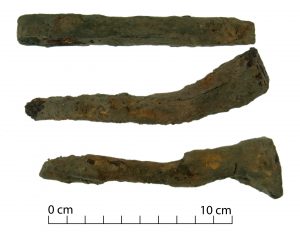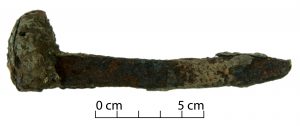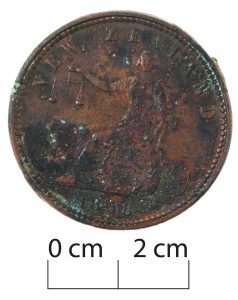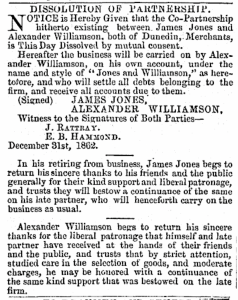Recording and preserving the Port’s history
There are 60 pre-1900 archaeological sites within the boundaries of the Port. These sites are evidence of both Māori and European activity in the area. As part of LPC’s commitment to preserve the history of the Port, archaeologists from Underground Overground Archaeology monitor any activities that expose archaeological features within these sites. Many artefacts have been discovered including domestic and commercial artefacts, building foundations, rail, drainage and Port infrastructure such as those pictured below. (all artefact images are courtesy of Underground Overground Archaeology unless otherwise stated).
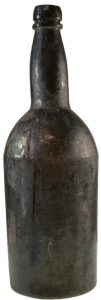
These alcohol bottles can tell us a little more about the life in Lyttelton and the place that alcohol had in society at the time. During the colonial times, which was when a lot of these bottles were likely used, drinking was a common occurrence in New Zealand life. Alcohol arrived with the arrival of the European settlers; it was not traditionally common for Māori to drink alcohol as they did not have their own form of alcohol before colonisation.
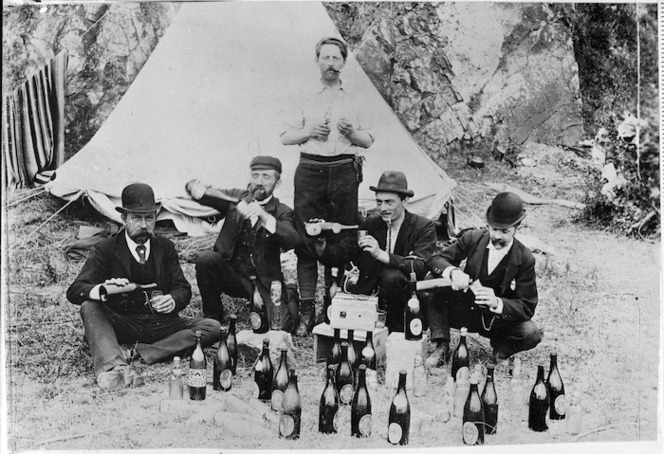
Typically, a quart of beer would cost between 6-9 pence, with a pint costing about 4 pence. Drinking was heavily associated with the social scene in the UK, Europe, and then New Zealand. People visited pubs in order to gain company and news, especially as there was not much in the way of entertainment in the colonies. Therefore, it is not surprising that so many alcohol bottles were found in Lyttelton, as it was a common part of daily life.
|
|
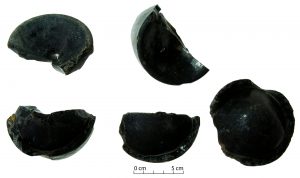 |
Logyard and Norwich Quay
There were many artefacts found in the inner log yard, but a large amount of them were glass alcohol bottles! All different shapes and types were found here, including different types of beer, wine, and gin bottles. Many of the bottles were likely manufactured and discarded between 1850s-1880s judged by the amount of remains and the style of bottle manufacturing. It is likely that these bottles were used many times over before they were thrown out, as there was no local bottle manufacturing industry in New Zealand in the nineteenth century and all of the glass bottles would have been imported from overseas. These bottles can show us what types of alcohols were popular in Lyttelton during the colonial period, and what types of bottles alcohol was typically stored in.
These pieces may have been associated with the Forbes building that was being used as a warehouse from 1863. As there was quite a large number of bottles found, it might indicate that it was stock that was broken or discarded or had simply been consumed by the people who worked or built the store!
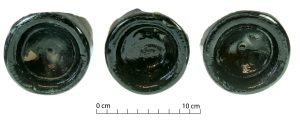 |
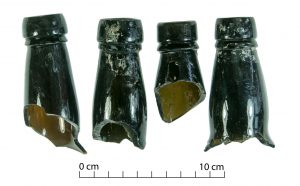 |
In the log yard there was also a complete ring seal wine/beer bottle found. Unfortunately, there was no embossment present on the bottle, but it is consistent with nineteenth century manufacturing. This is one of the only whole glass bottles found throughout the LPC archaeological sites.
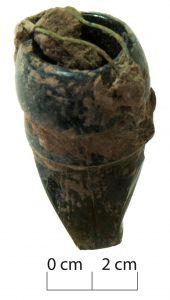 In this site, there was also a bottle that still had the cork and wire in the top, which is pretty unusual. It could suggest that the bottle was thrown out or broken before use, as there are not many bottles found that still had the cork intact. It may be that the contents of the bottle had spoiled, which was why it was thrown away.
In this site, there was also a bottle that still had the cork and wire in the top, which is pretty unusual. It could suggest that the bottle was thrown out or broken before use, as there are not many bottles found that still had the cork intact. It may be that the contents of the bottle had spoiled, which was why it was thrown away.
Te Ana Marina
Not too many alcohol bottles were found in Te Ana Marina, but the assemblage did feature pieces of the two most popular types of bottles found on Lyttelton archaeological sites, ring seal bottles and black beer bottles. Both bottles though would have likely been used many times and for a variety of different things, making it hard to say for sure what the purpose of these bottles were, other than alcohol, before they were discarded.
Below are examples of what complete beer bottles used to look like. On the left is a pint size bottle, whilst on the right is a quart size.
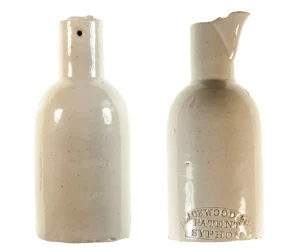
Found in the Inner Log Yard, this bottle is the remains of the Patent Syphon ink bottle from the company Blackwood & Co., who were prominent ink manufacturers located in London. Founded in 1843, they quickly became a popular choice for ink and their influence spread across the world, especially to New Zealand. Products by Blackwood and Co. were first advertised in 1861 in the newspaper Otago Witness, and continued to be imported well into the twentieth century.
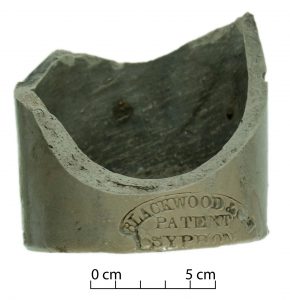 |
This particular bottle is known as the Blackwood and Co. Patent Syphon as it was a distinctly different shape than typical ink bottles, and only would have been created by them. This type of bottle, whilst missing the majority of the top, would have had a syphon spouted finish. This removed the need for a cork stopper and instead the bottle had spout and holes which made it easier to transfer ink from the bottle to smaller inkwells.
Whilst this bottle made it easier to transfer ink, they became far less popular when the fountain pen was invented, which had its own ink canister which needed to be refilled far less often than inkwells and thus changed the amount of ink people needed to have on hand.
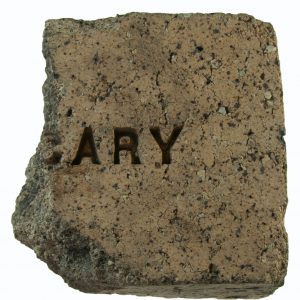
Gladstone Pier was a key part of inner harbour port operations, from its construction in February 1874 until it was damaged in the Christchurch Earthquakes in 2010-2011.
The pier was named after the first ship to dock there, the W.E Gladstone. Gladstone Pier had many changes over the years, including extensions, reconstructions, and repairs. The first extension happened in 1878, when plans for the pier to be extended by 504ft were approved to create additional space for berths. In August 1879, train rails were placed down which made it ready for berthing vessels.
Gladstone Pier had many repairs over the years, the first recorded in December 1879, before major construction work began in 1914. This work affected the outer arm, and aimed to straighten, lengthen, and widen it. These changes were extremely important for the port as it meant that longer vessels (up to 560ft!) could now dock there. In the twentieth century, there were two main additions to the pier, an extension around the lighthouse at the southern end, and a drive-on terminal added between the outer and inner arms.
Gladstone Pier was damaged extensively in the earthquakes and was out of use until its demolition in 2017. As the pier was unsafe, the demolition was done using an excavator on a barge alongside the side of the pier.
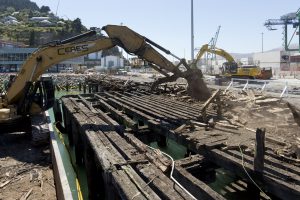 |
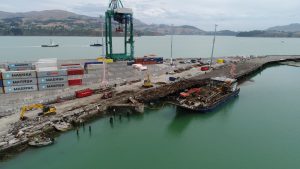 |
The pier was recorded as an archaeological site and many timer samples and photographs were documented which demonstrate the demolition process.
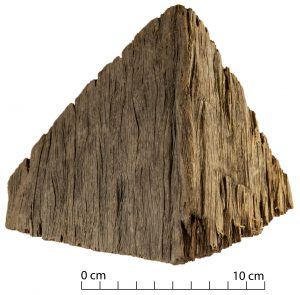 |
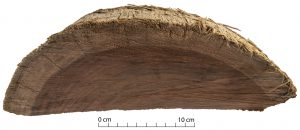 |
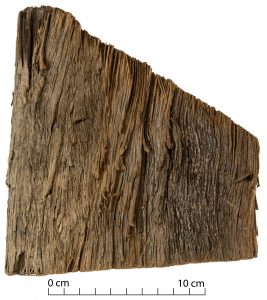 |
The artefacts found in this process were mainly refractory brick and tile fragments (also known as fire bricks and fire tiles), which were likely used in fireplaces or furnaces as they were heat resistant. The bricks however could have also been used as ballast, which were heavy substances placed to improve stability and control on vessels. It is unusual to find bricks from Otago and Scotland which is why it indicates it could be ballast. From these bricks we can gather information about the refractory brick and tile businesses that were used in Lyttelton, or in trade networks, as there were three company marks visible.
The first mark visible is on the two bricks, the mark ‘[TO]DD’, was used by brick manufacturer Thomas Todd. Located in Otago, Todd was first advertised as a brick manufacturer in 1888 and operated until they were purchased by McSkimming Industries between 1936-1938. There is no way to know an exact date for this tile, but between 1888 and 1938 is the best guess.
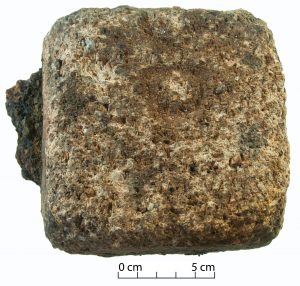 |
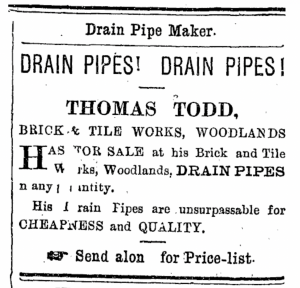 |
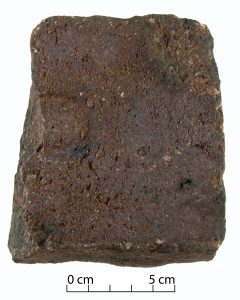 |
Source: Matarua Ensign, Volume 11, issue 823 (09/11/1888)
The second mark was found on tile fragments, each being roughly half of a whole tile, with the mark ‘CASTLECARY’ who were a Scottish fireclay company. Castlecary was established by 1883 and were exporting tiles to New Zealand into the twentieth century, with the height of exportation being in 1927.
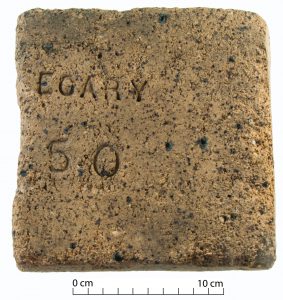 |
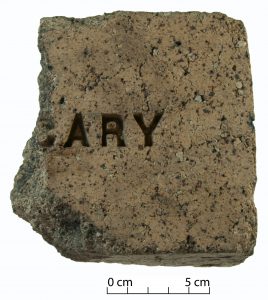 |
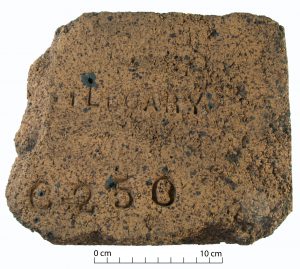 |
The third mark found on the tile fragments has the mark ‘STARWORKS GLENBOIG’ which was a different Scottish fireclay company, under the name Glenboig Fireclay Company. First established in 1882, the Glenboig Fireclay Company were exporting bricks to New Zealand for many years, until the company merged with Castlecary works in 1936 to become a larger company.
The large range of manufacturing dates for these materials can’t provide an exact date nor an exact purpose, but they provide more information about the trading business in New Zealand, and where these types of products can come from.
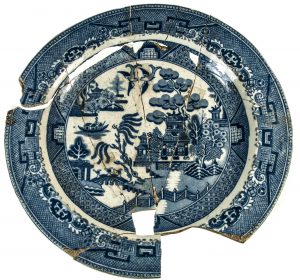
Through archaeological sites, we can find lots of information about the types of items that were used in everyday households, ranging from plates to cups to even chamber pots! The decoration and materials can indicate the trends of the time, and the potential wealth of the person who owned it. These pieces show us more about the lifestyle of the people living and working in Lyttelton. These pieces would have been made in England and imported to Lyttelton, demonstrating how important trade and imports were in the colonial period, despite New Zealand being on the other side of the world.
Inner Log Yard
This artefact consists of two fragments from a whiteware dinner plate found in the Inner Log Yard. The decoration featured is the Country Scenery transfer print. This particular pattern was credited to Lockhart and Arthur, and the firm David Lockhart and Co. The firm was operating from 1855-1864 and 1865-1989 in Scotland. However, there are no clear indicators on these fragments that they come from the firm, but it is likely given the design.
These artefacts are fragments from a teacup that has been decorated with sailor motifs. This style of transfer print was produced between the late eighteenth and late nineteenth century, with peak its period between the 1830s and 1850s. It is quite cool to see domestic pieces with sailor motifs found near Lyttelton, given the importance of the sea for Lyttelton and its community.
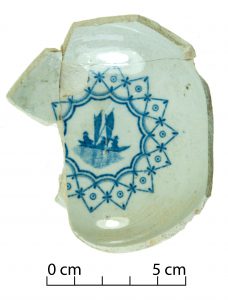 |
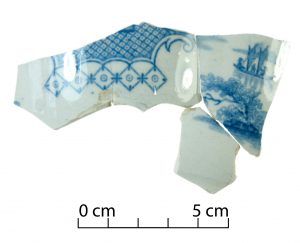 |
7 Norwich Quay
The artefacts from 7 Norwich Quay were all rather small, which means it is difficult to identify what the items were. However, it can be assumed that they were generally tea and table wares, with some being household items and stoneware vessels. From this site, there are two pieces that feature patterns from other nations which indicates popularity of such patterns.
This piece is from a teacup that features a Rhine pattern, which was one of the most common patterns on ceramic pieces in nineteenth century New Zealand. As the name suggests, this particular design was influenced by the Rhine River in Europe. This pattern consists of a castle surrounded by water, trees, and foliage. As it was a very common pattern, and only a small fragment remains, it is not possible to identify a specific manufacturer, but it is likely that it dates to the latter half of the nineteenth century when the pattern was being produced by many manufacturers.
This is a piece from a decorated plate, which features Chinese motifs in the design. We can tell it includes Chinese motifs through the combination of geometric and foliage elements, including orange trees and junks. As indicated, this would have been influenced by the nature and landscape of China and Chinese porcelain. These designs were produced from the late eighteenth century to the mid nineteenth century, with the peak production period being between 1797 and 1814, and it was the most common pattern influence during this time.
Te Ana Marina
There were multiple ceramic fragments uncovered at the Te Ana Marina site, and they can further demonstrate the importance of patterns and how they can explain more about which patterns were popular in Lyttelton, and furthermore in New Zealand. The following pieces were two of the most popular and common patterns in New Zealand during the nineteenth century.
These fragments are from a dish and plate, and they are decorated with the Asiatic Pheasants pattern. This pattern was extremely popular and is the most common pattern found in archaeological sites in New Zealand. Its key design features included one or more pheasants amongst flowers and plant leaves, with a floral border on the rim. This pattern was produced by a variety of Staffordshire manufacturers in England throughout the nineteenth century.
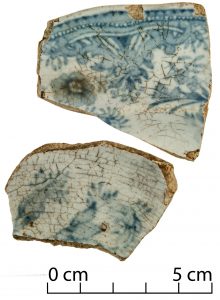 |
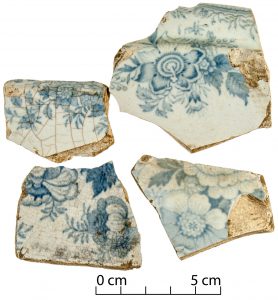 |
This fragment, whilst small, displays the edge of a willow tree. The Willow pattern was an extremely popular pattern, and even still gets used today on modern ceramic pieces! Found on many archaeological sites across Christchurch, it was first designed at the end of the eighteenth century as a response to the popular Asiatic motifs that were featured on a lot of whiteware from that time.
Below are complete examples of the Rhine, Asiatic Pheasants and Willow patters to demonstrate what the pieces discovered in Lyttelton would have looked like:
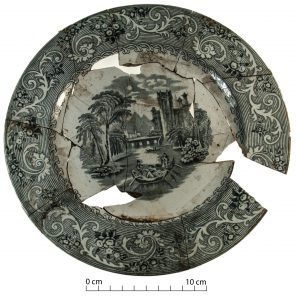 |
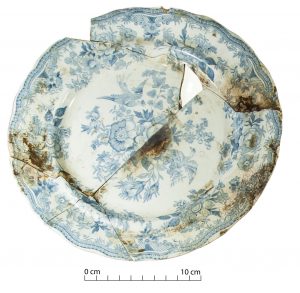 |
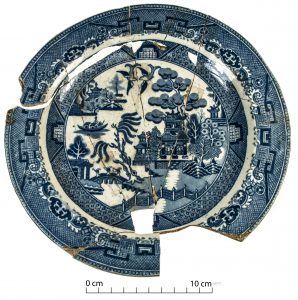 |
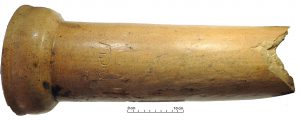
This artefact is a well-preserved earthenware drainpipe from the Brick Barrel Drain site off Norwich Quay. This pipe was found connected into a brick manhole and whilst it is unknown exactly what this particular pipe was used for, it would have most likely been a wastewater lateral that connected into the brick barrel main in the street.
This pipe displays a clear inscription reading ‘R. O. Clark’ which refers to the manufacturer of the pipe. In 1854, Rice Owen Clark had purchased land in Hobsonville, Auckland, becoming the first European settler in that area. However, his land was far too wet for farming, and he soon discovered there was an abundance of clay and began to fashion his own pipes and tiles to drain excess water off his land.
With the continuous arrival of settlers, the demand for drainpipes increased which led Clark to purchase a tile-making machine. In 1864 Clark officially established his own pottery business, where they would produce bricks, tiles, and pipes manufactured from clay.
Image Source: Factory of R O Clark’s brick and pottery works, Hobsonville. New Zealand. Department of Labour :Photograph albums for the International Exhibition, Christchurch, 1906-1907. Ref: PA1-o-370-20. Alexander Turnbull Library, Wellington, New Zealand. /records/23056118
Clark was one of the most popular pottery businesses in Auckland and despite challenges such as competition, price wars, and the collapse of the building industry in 1888, they were in business for nearly 80 years until the clay in Hobsonville ran out in 1920.
This particular pipe had features that indicate it was dated to the 19th century, as it had a curved collar/profile with a height of 36mm which was not common after the developments to pipe manufacturing at the start of the 20th century. As this artefact was found in Lyttelton, it is clear that R. O. Clark sold pipes throughout the country, not just Auckland. The choice to use an imported pipe from another region in New Zealand may have irked local Christchurch and Lyttelton pipe manufacturers. As mentioned, the exact purpose of the pipe is unclear but given the purpose of other pipes in this design, it was likely used as an outflow into the brick barrel drain.
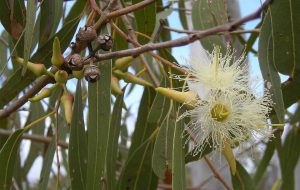
This bottle is the remains of an extremely popular product from the late nineteenth and early twentieth centuries: Sanders and Sons Eucalypti Extract. Found in Te Ana Marina, it helps us to understand more about the ways that people treated illness and injury in the nineteenth and twentieth centuries, and what remedies were available to them.
The bottle is a small, circular clear bottle with the top half unfortunately missing. It does have the embossing SANDER & SONS/ EUCALYPTI / EXTRACT, which is a clear identifier as to the contents of the bottle. We also have an example of a complete bottle to see what it looked like before it got broken.
Sanders and Sons were a company based in Victoria, Australia, that took New Zealand by storm. First advertised in 1877 in the New Zealand Herald, Sanders and Sons Eucalypti Extract rapidly became a nationwide success. It was believed to cure a wide range of illnesses, including the common cold, influenza, bronchitis, wounds, burns, ulcers, skin diseases, with one customer even stating that it prevented the amputation of his leg!
Mentioned in multiple newspapers all over the country, the most outstanding testimony came from Franz Raabe who declared in front of J.P. Moritz Cohn that Sander and Sons Eucalypti Extract saved his sons leg from being amputated. Raabe stated that his son was accidentally hurt by an axe to the knee, and despite the doctor’s best efforts, the last remaining option was to amputate his leg in order to save his life. However, Raabe decided to try the Eucalypti Extract he had heard about and said he ‘had the satisfaction of seeing my son within a fortnight all out of danger.’ Certainly an incredible feat!
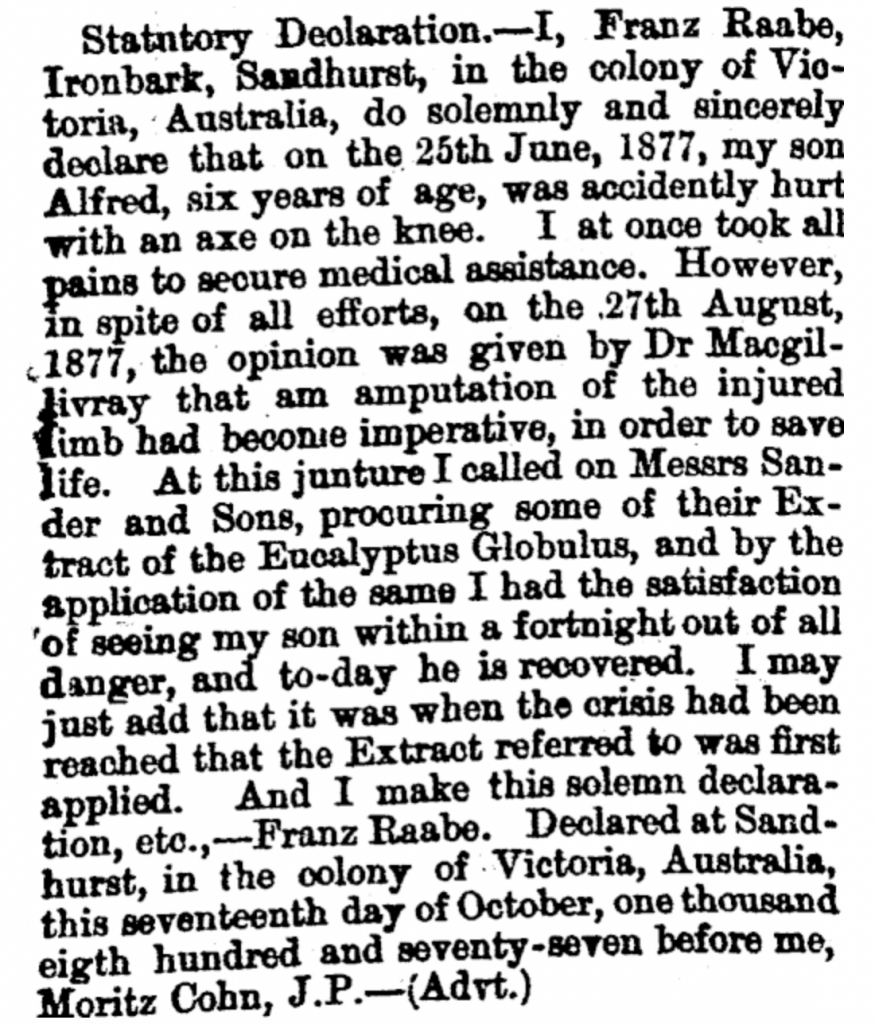 |
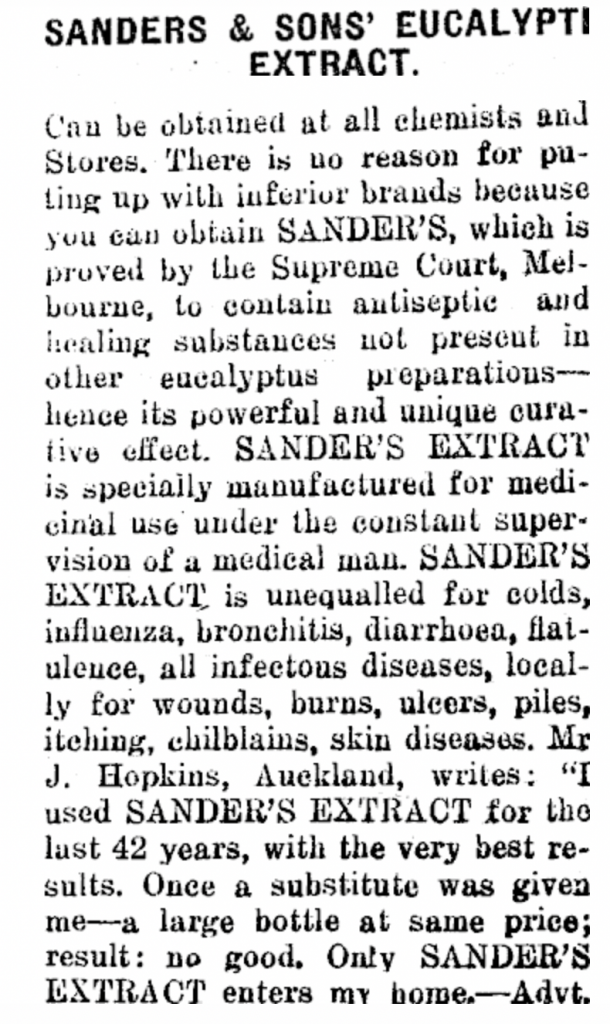 |
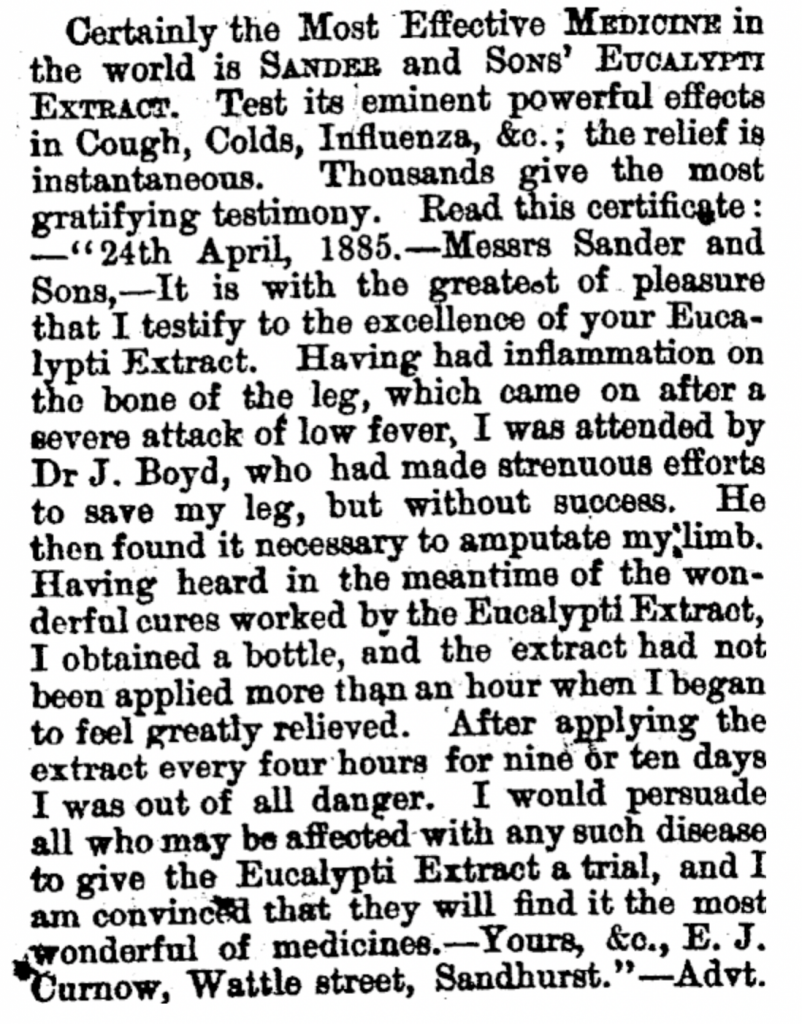 |
Newspaper Clippings (left to right):
Bay of Plenty Times Volume XV, Issue 2100 (12/02/1887), Manawatu Herald, Volume XLVI, Issue 2800 (21/10/1924), Bay of Plenty Times Volume XV, Issue 2100 (12/02/1887)
Nearly 40 years on from Raabe’s testimony, Sanders and Son posted an advertisement stating that their product was available in all chemists and stores across New Zealand, so that no one would have to settle for ‘inferior brands’. This provides us with information on one of the most popular products in New Zealand at the time, and that it must have been quite a popular product to end up all the way in Lyttelton.
‘A Cure for all Ailments’
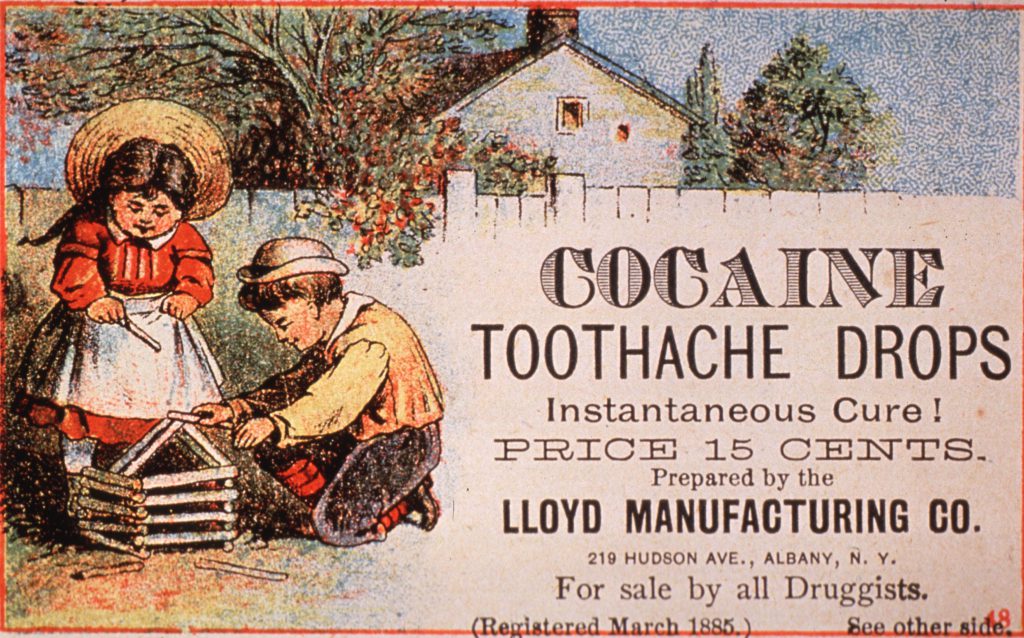
It is likely however that the Eucalypti Extract was simply eucalyptus oil, but the company claimed to cure a wide range of diseases, which means the testimonies and advertisements found in newspapers need to be taken with a pinch of salt. It is very unlikely that simple eucalyptus oil was the only thing that was able to save a leg from being amputated! This type of ‘cure all’ claim was not unusual for the time.
In the nineteenth century, there were no laws or regulations on the production of medicine. People could produce and sell what they wanted and did not have to state the ingredients as they do today. Because of this, there were a large number of ‘cure all’ medicines available that people could purchase over the counter. These medicines typically included a combination of alcohol and opioids and claimed to cure anything from simple headaches to life-threatening illnesses such as tuberculosis. It is known that cocaine pills were even distributed as a painkiller for toothaches!

Boots were made both locally and were imported from Britain, with imported boots costing only £1 in the 1850s! How cheap! However, that does roughly equal between $100-$150 today. As boots were in high demand in New Zealand, many individual bootmakers started their own local businesses after they arrived in New Zealand, where they made their own boots but also sold imported products to help meet the high demand.
The government, in their efforts to get people to support local businesses, implemented a duty of one shilling per pair of boots that were imported. But even then, imported products were still more popular: in 1880 there were 500,000 imported boots sold compared to 280,000 local products. The reason for this was likely that the New Zealand made boots were rougher and made for the lower end of the market.
These are fragments from a pair of adult boots found in the inner log yard. In New Zealand, it was crucial for people to own a strong pair of boots in the colonial period, as walking was one of the main methods of transportation at the time.
These particular boots have been manufactured using wooden pegs to attach the sole to the upper. While the pegs themselves have rotted away, we can tell that they were constructed using pegs rather than nails based on the shape of the hole that was left by the peg. This type of shoe construction is the most common method of shoe construction seen on Christchurch shoes from the nineteenth century, and the use of wooden pegs rather than nails suggests that the boots were probably made between the 1850s and 1870s.
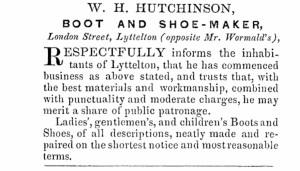 |
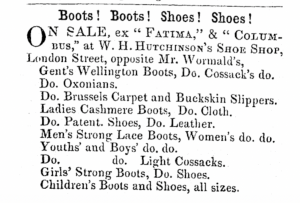 |
Lyttelton Times 13/12/1851 Lyttelton Times 13/03/1852
Lyttelton had its very own shoemaker, W. H. Hutchinson, located in London Street, from 1851. W. H. Hutchinson sold a wide variety of footwear for men, women, and children, including boots, slippers, and shoes.
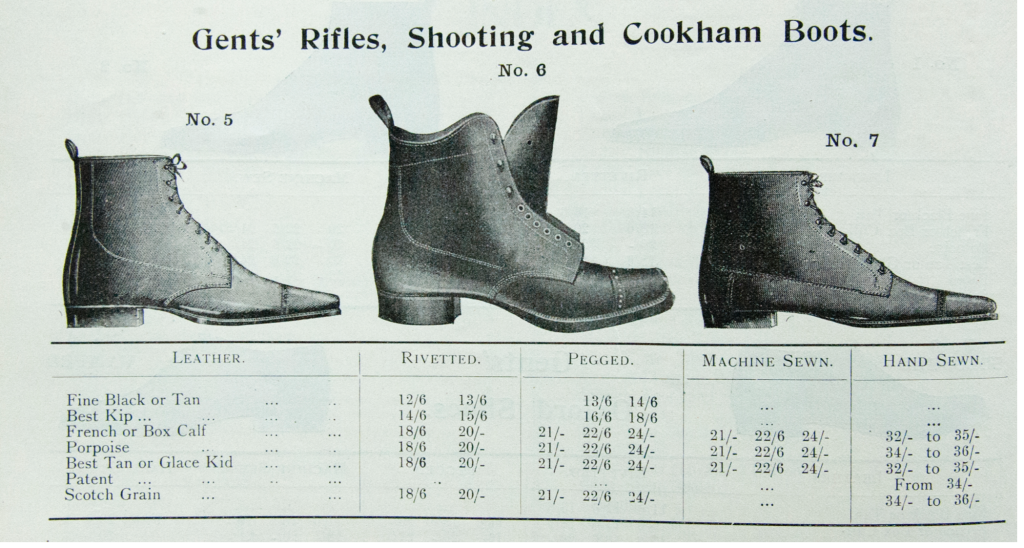
We also have a catalogue from Christchurch boot-maker H. Pannell in 1903-1904, which displays the different types of footwear that were being made in the nineteenth and twentieth centuries in New Zealand. The shoe found in Lyttelton was likely a derby style based on the lack of stitching displayed on the upper, which would have looked similar to these advertised boots.
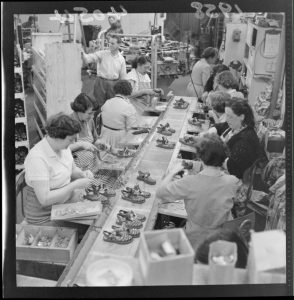 With the introduction of shoe-making factories in New Zealand, it is also interesting to learn that the factories had both men and women employed. Women actually made up roughly a third of the workforce in footwear factories throughout the nineteenth and twentieth centuries! The women’s roles in footwear factories were typically jobs such as making uppers and doing thread work. There was definitely a pay gap though: women were being paid between 5-25 shillings a week whilst men were being paid about 25-55 shillings a week, which is not an overly surprising statistic for the time. However, it is still very cool to see women have a prominent place in the workforce during this time!
With the introduction of shoe-making factories in New Zealand, it is also interesting to learn that the factories had both men and women employed. Women actually made up roughly a third of the workforce in footwear factories throughout the nineteenth and twentieth centuries! The women’s roles in footwear factories were typically jobs such as making uppers and doing thread work. There was definitely a pay gap though: women were being paid between 5-25 shillings a week whilst men were being paid about 25-55 shillings a week, which is not an overly surprising statistic for the time. However, it is still very cool to see women have a prominent place in the workforce during this time!
Image Source: Unidentified female workers assembling plastic shoes at Buchanan and Edwards shoe factory. Evening post (Newspaper. 1865-2002) : Photographic negatives and prints of the Evening Post newspaper. Ref: EP/1958/4054-F. Alexander Turnbull Library, Wellington, New Zealand.
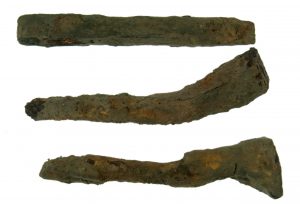
During the colonial period, there was a lot of rapid change in the Lyttelton area in order to allow for trade to flourish. In 1864, there was a proposal made by Provincial Engineer Edward Dobson to introduce a railway terminus to Lyttelton Port in order to provide easier transport between the boats and the township.
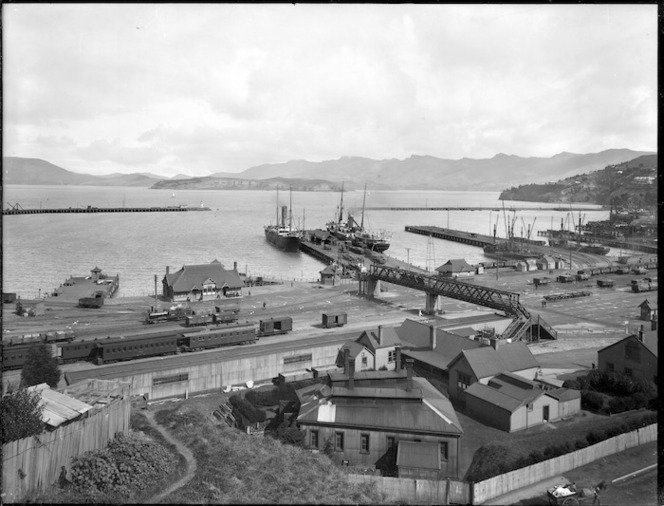
The proposal was first mentioned in the Lyttelton Times and discussed the many challenges involved in building the terminus. This included reclaiming enough land, extending the original wharf, and constructing a new wharf altogether. The need for this terminus was likely also connected to the continued work on the railway tunnel, which intended to provide an easy link between Lyttelton and Christchurch. After four years of construction and reconstruction, the reclamation was open for use for locomotives in 1868.
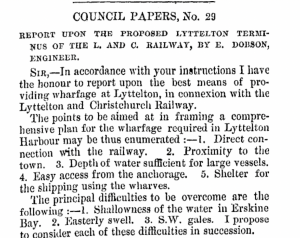 |
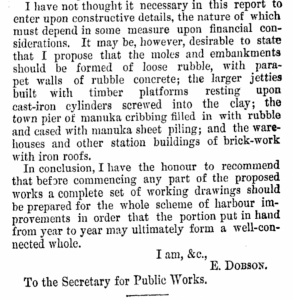 |
Image Source: Lyttelton Times Volume XXIX, Issue 2247 (04/03/1868)
Artefacts found in the inner log yard can tell us a lot about the railway construction and the types of construction materials that were used. These artefacts were mainly railway spikes varying in different shapes and sizes, including seven quite long spikes which may have been used to fix heavy timbers.
There was also a number of wooden features, such as railway sleepers, as well as a piece of rail line. These artefacts tell us a little more about how the railway was constructed and used.
Both the 7 Norwich quay and inner log yard sites had land that was part of the railway reclamation, and both have provided a wide range of artefacts, including ceramic, glass, metal, and wooden pieces. The sites can not only provide us with information about the lives in Lyttelton, but also about what the land may have been used for before being adapted for the railway reclamation.
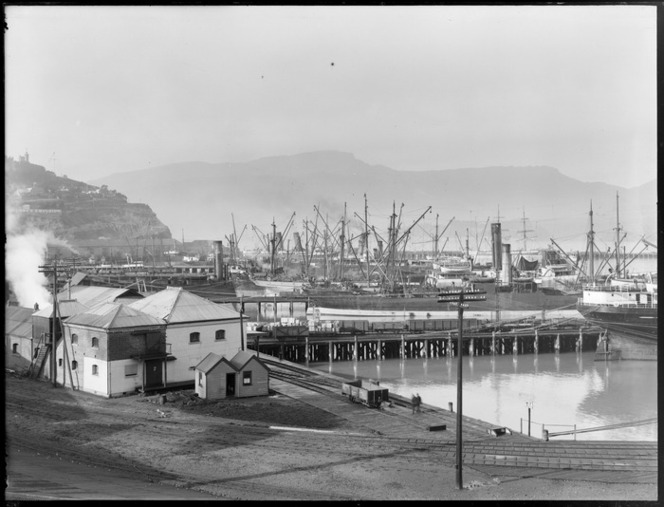
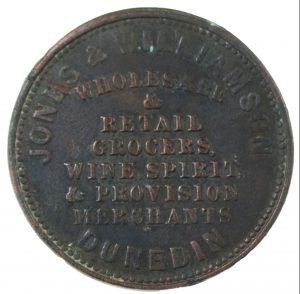
Everyone is familiar with money; we use it every day. But this type of coin was only used for 40 years and displays to us just how different our current economy is compared to the colonial period economy. This particular coin was found at the 7 Norwich Quay site.
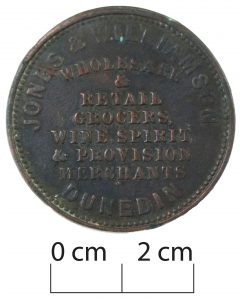 This type of coin, typically referred to as a ‘trade token’, was a common type of currency in multiple cities in New Zealand during the nineteenth century. As a result of money shortages in New Zealand during the colonial period, these types of tokens were legal tender in Christchurch from 1857 to 1897 as small change. They were not official New Zealand currency, but the government recognised it was a necessary option at the time.
This type of coin, typically referred to as a ‘trade token’, was a common type of currency in multiple cities in New Zealand during the nineteenth century. As a result of money shortages in New Zealand during the colonial period, these types of tokens were legal tender in Christchurch from 1857 to 1897 as small change. They were not official New Zealand currency, but the government recognised it was a necessary option at the time.
The tokens were typically commissioned by a local businesses in order to provide a method of payment, but they also provided advertising for the business too! In 1881, the British government announced that it was able to supply genuine coins to New Zealand which meant tokens were no longer issued from then onwards, but they did remain in circulation until 1897 when they were demonetised.
This token features the year it was minted, 1858, and Justice on one side, and the details of the business on the reverse. The business that commissioned the token was ‘Jones & Williamson’ who were grocers, wholesalers, and provision merchants. This particular partnership began in 1853 and ended in 1862, as reported in the Otago Daily Times. Jones and Williamson was located in Dunedin, which is curious as it is likely the token would not have been accepted as tender anywhere in Christchurch or Lyttelton. Perhaps this is why the token was thrown out!
Coins and tokens are not often found in archaeological sites, as there are not many people who would willingly discard of their money, which makes this a very interesting find and can tell us a lot about life in New Zealand during this time. It also tells us a little bit more about the life here in Lyttelton, as it indicates trade patterns and types of shops that were operating at the time.
